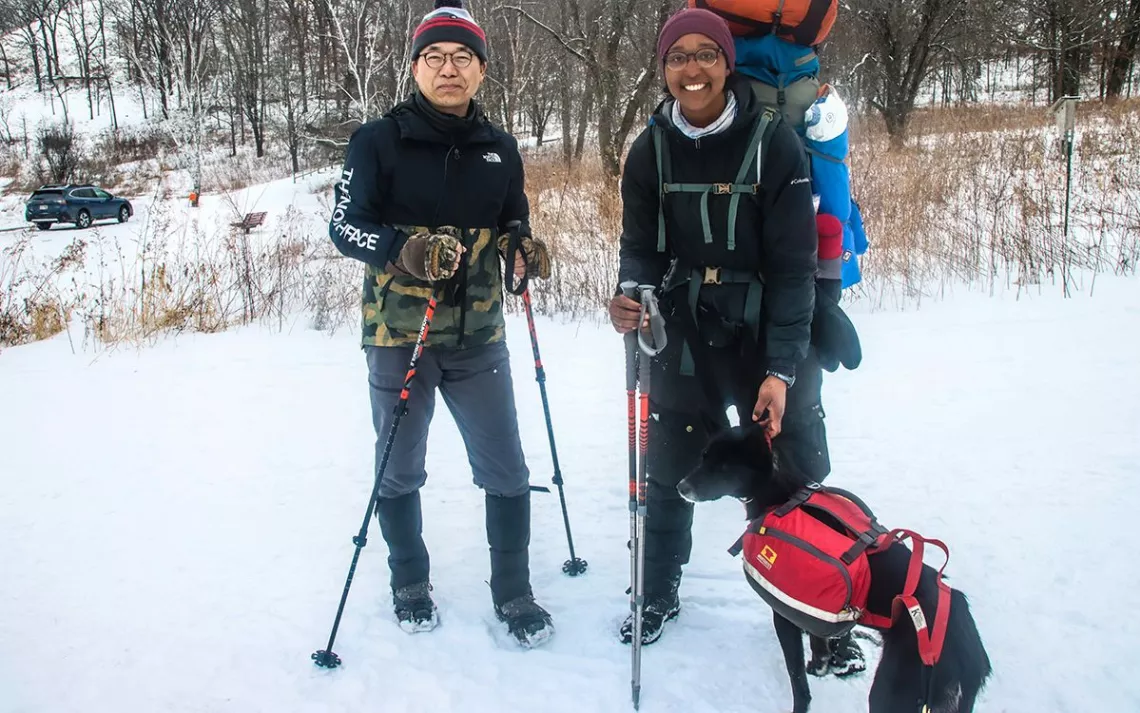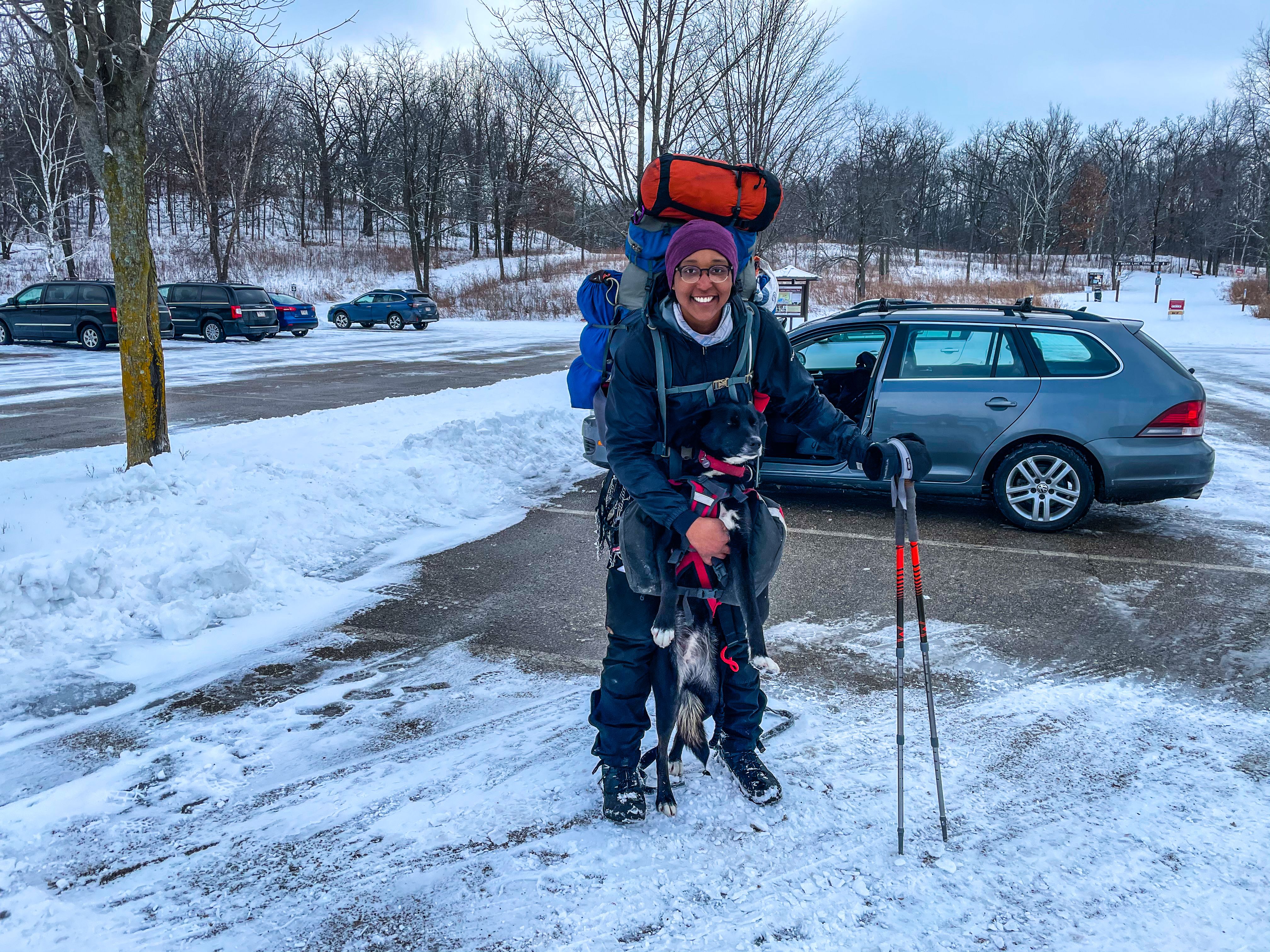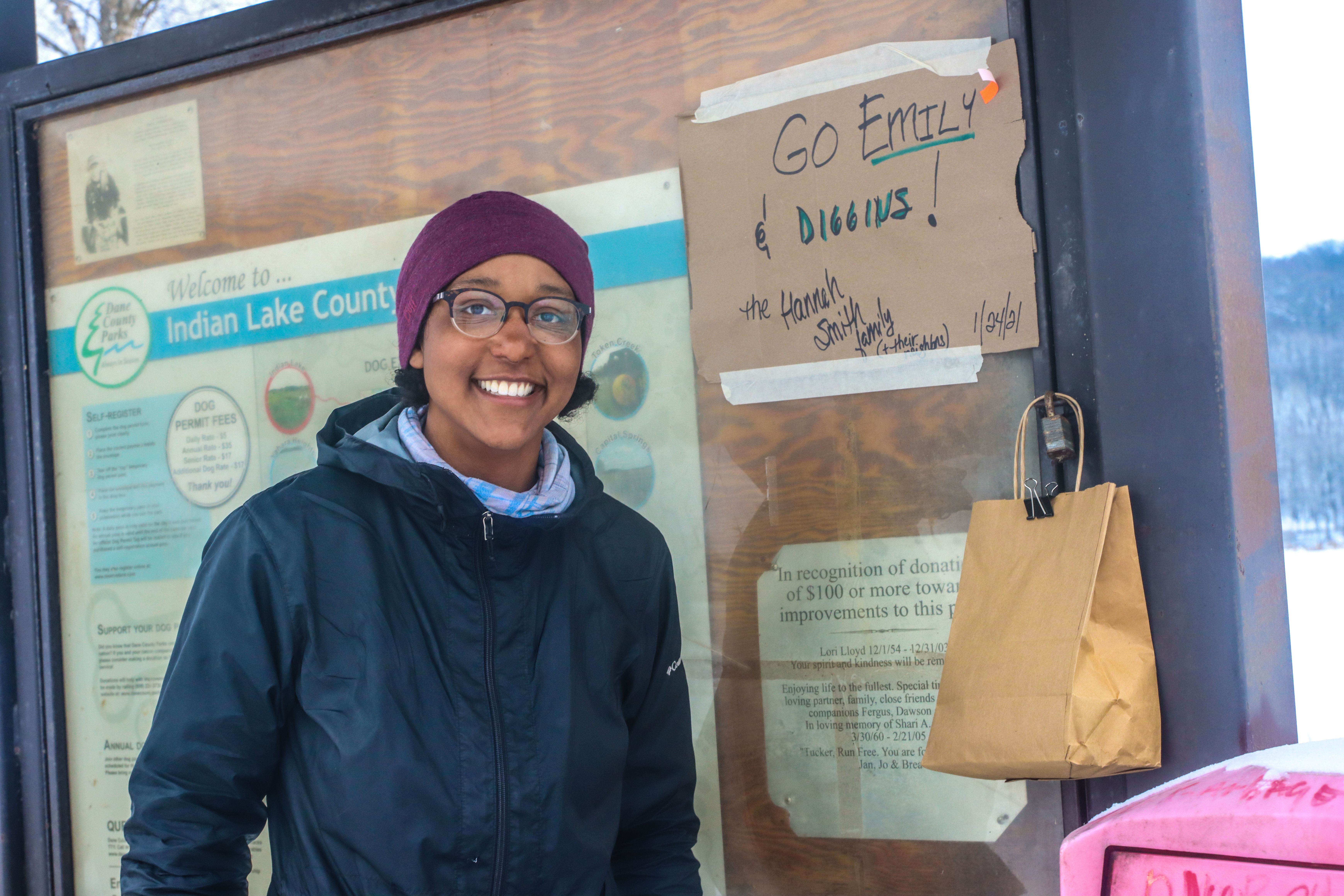On the Trail of Hiker Emily Ford
She’ll be the first Black woman to thru-hike the Ice Age Trail in winter

IAT thru-hiker Emily Ford with IAT section hiker (and aspirational thru-hiker) Xiping Wang.
|Photos by James Edward Mills
In and of itself, the journey across Wisconsin’s Ice Age National Scenic Hiking Trail is a monumental undertaking. But the 1,200-mile walk from Potawatomi State Park, on the shores of Lake Michigan, to the St. Croix River at the Minnesota border is made all the more daunting by the deep snow and frigid temperatures of a Wisconsin winter. Despite the hazards posed by prolonged exposure, thru-hiker Emily Ford, who set out from the eastern terminus in January, remains determined to complete the almost-three-month-long trek.
If she completes her journey, Ford will make history, not only as the first known woman to cross the IAT during winter, but as the first Black person to make the journey through the coldest months of the year. (She’ll also be the first person to complete the hike with an adorable husky named Diggins.)
 As inspiration, Ford cites the challenge of tracing the IAT’s path of a retreating glacier, one that last covered the Dairy State through the Pleistocene epoch, more than 11,000 years ago. Around 400 miles into her thru-hike, I caught up with Ford, whose journey had taken her near my hometown of Madison. “This was really the only time I could do it,” she told me. “The rest of the time I’m a gardener, and now is when I’m usually laid off.”
As inspiration, Ford cites the challenge of tracing the IAT’s path of a retreating glacier, one that last covered the Dairy State through the Pleistocene epoch, more than 11,000 years ago. Around 400 miles into her thru-hike, I caught up with Ford, whose journey had taken her near my hometown of Madison. “This was really the only time I could do it,” she told me. “The rest of the time I’m a gardener, and now is when I’m usually laid off.”
A lifelong resident of Duluth, Minnesota, Ford is no stranger to the cold. And at the age of 28, she’s accustomed to making her way across a frozen landscape. “The most I’ve ever walked before this was about 300 miles on the Superior Hiking Trail,” she said. “But this, yeah, it’s completely different.”
Though the topography and vegetation of Wisconsin and Minnesota are similar, the hiking conditions aren’t quite the same. Not only is the Ice Age Trail four times longer than the Superior, but it also includes long sections of travel through the paved streets of small towns as well as urban communities. “There are more than 500 miles of walking along highways,” Ford said. “I’ve already worn out one pair of hiking boots, over that kind of terrain.”
As a trained sled dog, Diggins, who’s walked every step with Ford, is also used to cold weather. But after so many long miles logged on the road, even her rugged paw pads require regular treatments of moisturizing suave to heal. February’s obscenely low temperatures are presently taking a toll on both woman and dog—day after day of -40º windchill, after all, is not only unpleasant; it’s life-threatening. “I mean, I grew up in Minnesota and it gets this cold, but I’ve never had to be out in it every day,” Ford told me. “I’ve let my ego go and have been trying to stay inside on those nights. It was a bit much for Diggins and myself.”
Still, most nights, she and Diggins sleep in a tent. On occasion, Ford accepts the hospitality of trail angels—kind folks who live near the IAT and generously offer a warm bed for a night, and often with it, a hot meal. Otherwise, Ford is making her way via the power of her own two feet. But with an ever-growing fanbase following her journey on Instagram, she enjoys ample moral support from thousands of well-wishers throughout the hiking community.
“Darned near every post we do has skyrocketed to a reach of 80,000 to 100,000!” reports Mike Wollmer, executive director of the Ice Age Trail Alliance, the nonprofit organization that manages the trail. “[Ford has] been a great advocate for herself, the Trail, and the Alliance.”
 As she makes her way through trail communities across Wisconsin, Ford’s fans make every effort to find her and offer up her favorite snacks and words of encouragement. (She’s especially fond of Skittles and pretzel bites filled with peanut butter.) But on the long stretches between visits, many of which are with complete strangers, Ford admits she gets a bit lonely.
As she makes her way through trail communities across Wisconsin, Ford’s fans make every effort to find her and offer up her favorite snacks and words of encouragement. (She’s especially fond of Skittles and pretzel bites filled with peanut butter.) But on the long stretches between visits, many of which are with complete strangers, Ford admits she gets a bit lonely.
“The biggest challenge is the mental stuff really. Learning to say goodbye to people day after day and never see them again, or seeing no one for days,” she said. “In the winter, solo hiking can be isolation hiking.”
But Fords seems to take the anguish of loneliness in stride—along with the many other challenges inherent to the arduous experience that is a wintertime thru-hike. She understands that, along with the physical burdens of a 65-pound backpack and frozen hiking boots, she carries the added responsibility of doing something no Black woman has ever done before. And though it was never her intention to make a public spectacle of her trip, Ford knows that she now serves as a role model to others who may one day challenge themselves to achieve something superlative.
“I hope that it means something to others—that they feel like they can move forward with their dreams,” she said of her journey. “This is just a little drop in the ocean of equality. But every little drop helps.”
To be the first Black, openly gay woman to hike the Ice Age Trail does indeed carry special meaning. And to be the first in a category where once there were none, means she’s forging her own trail with her footsteps—one almost sure to draw followers.
 The Magazine of The Sierra Club
The Magazine of The Sierra Club



